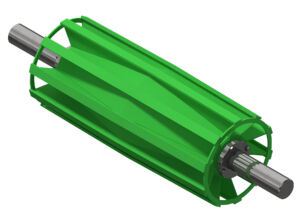When operating complex industrial conveyor systems, proactive maintenance and a deep understanding of common failure points are paramount to ensuring efficiency and longevity. Early failures can lead to costly downtime, reduced productivity, and increased maintenance expenses. By addressing issues like slippage, material spillage, and carryback, businesses can extend the lifespan of their industrial conveyor system parts and optimize overall performance.
Understanding and Mitigating Slippage
Slippage represents a significant challenge within industrial conveyor operations, directly impacting efficiency and accelerating wear on some of your system’s most important components. To effectively address this, consider the following points:
- Slippage occurs when there’s insufficient friction between the drive components and the conveyed material or mechanism, leading to a loss of propulsion and potential wear on system elements. This can result from inadequate tension, worn drive drums, or the presence of contaminants.
- The consequences of slippage include reduced material flow, increased energy consumption, and premature wear on drive-related industrial conveyor system parts.
- Prevention involves ensuring proper component alignment, maintaining optimal drive traction, and regularly inspecting and cleaning all associated system elements.
Controlling Material Spillage
The unintended escape of conveyed material, known as spillage, poses both operational and safety concerns within industrial environments. Effective management of spillage is crucial.
- Material spillage often occurs at transfer points, loading zones, or due to improper system design and/or maintenance.
- Beyond material loss, spillage can create safety hazards, contaminate the surrounding environment, and lead to significant damage or accelerated wear on rollers, idlers, and other structural industrial conveyor system parts if material accumulates around them.
- Effective control measures include optimizing loading conditions, installing appropriate skirting and containment systems, and regularly clearing any accumulated spillage from around the system.
Effectively Addressing Carryback
Carryback, where material adheres to and is transported back by the return side of the system, can cause persistent issues that undermine efficiency and component integrity. Proactive solutions are necessary.
- Carryback will often fall off at unintended locations along the return path, leading to material buildup, increased wear and tear, and tracking issues.
- Solutions include implementing effective cleaning systems, selecting appropriate component materials, and ensuring that return-side components are regularly inspected and maintained to prevent the accumulation of materials.
Invest in Longevity with Luff Industries
By proactively addressing these common challenges through diligent inspection, timely maintenance, and strategic selection of high-quality industrial conveyor system parts, companies can significantly reduce the risk of early failures. Investing in well-engineered components ensures that your system operates reliably, minimizing downtime and maximizing productivity for years to come.
For durable, reliable industrial conveyor system components designed to withstand the rigours of heavy-duty operations, explore Luff Industries’ range of solutions.
Have questions or want to learn more? Contact us.




